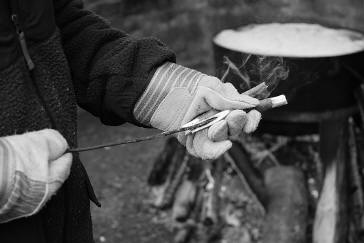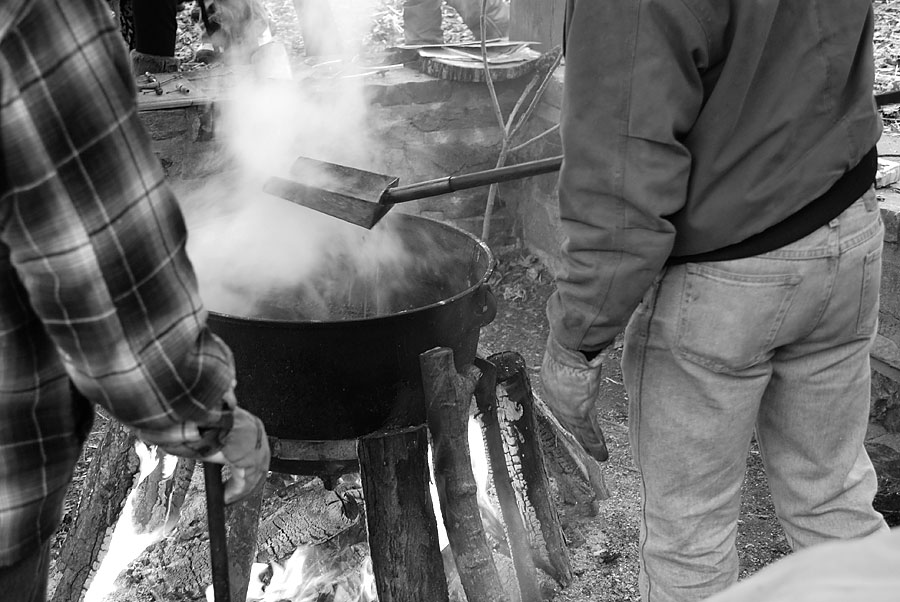Making Maple Syrup
Tim Iverson
(3/2015) Maple syrup, as the name implies, comes from the Maple tree, usually the Sugar, Red, or Black Maple. During the summer months the leaves of trees create sugar, which is stored as starch in the roots and trunks prior to winter. With the onset of spring trees will convert these starches back into sugar. The sugar combines with ground water to
create sap, and the sap rises in the tree with the advent of warmer weather. In February winter begins to wane, and sugar makers venture out to tap Maples in anticipation for the coming seasonal changes.
 To tap a tree a sugarmaker will bore a hole into a tree and insert a spile, or tap, to collect sap. The warm days and cold nights, generally 40-45EF high and 30EF
or below low, build up pressure within the tree and causes sap to flow out. This process is entirely sustainable, and is a lot like a person donating blood. Once a Maple reaches 30 to 40 years old it can be tapped. A tree can support between one and three taps at a time, and will produce 9 – 13 gallons of sap in a given season. At this point the syrup making process is far
from over. The collected sap must be boiled down to create the syrup.
To tap a tree a sugarmaker will bore a hole into a tree and insert a spile, or tap, to collect sap. The warm days and cold nights, generally 40-45EF high and 30EF
or below low, build up pressure within the tree and causes sap to flow out. This process is entirely sustainable, and is a lot like a person donating blood. Once a Maple reaches 30 to 40 years old it can be tapped. A tree can support between one and three taps at a time, and will produce 9 – 13 gallons of sap in a given season. At this point the syrup making process is far
from over. The collected sap must be boiled down to create the syrup.
It takes 40 gallons of sap to make just one gallon of syrup. Sap collected from trees is mostly water and contains about 2% sugar. Maple syrup typically contains 66% sugar, so to achieve this syrup producers send the sap through a reverse osmosis machine to extract most of the water. The remaining sap is then boiled down to evaporate the rest of the
water and thicken the sap. As the water evaporates the sap thickens and sugar crystallizes.
 A sugarmaker continually tests the thickness and viscosity during this process. Once the pan reaches 219 degrees the syrup is siphoned off and is filtered to remove by-products like sugar crystals
that affect grittiness or flavor. After filtering the syrup is adjusted for density and graded on color and flavor. The U.S. and Canada, even some states (Vermont, New Hampshire, and New York), have different scales of classification. Grade A generally includes the light to medium colored syrups with mild flavors – these are table syrups used for pancakes, French toast, and
that that sort of thing. Grade B is dark and has an intense flavor and is primarily used for cooking.
A sugarmaker continually tests the thickness and viscosity during this process. Once the pan reaches 219 degrees the syrup is siphoned off and is filtered to remove by-products like sugar crystals
that affect grittiness or flavor. After filtering the syrup is adjusted for density and graded on color and flavor. The U.S. and Canada, even some states (Vermont, New Hampshire, and New York), have different scales of classification. Grade A generally includes the light to medium colored syrups with mild flavors – these are table syrups used for pancakes, French toast, and
that that sort of thing. Grade B is dark and has an intense flavor and is primarily used for cooking.
Syrup producers generally take production, regulation, and grading pretty seriously. Vermont arguably has the strictest standards in the US. You can’t label anything as Maple Syrup if it isn’t made with 100% pure maple syrup, and they even got into a legal battle with McDonalds over the issue. While there are legal standards for syrup it’s mostly
industry regulated. The real deal Maple syrup isn’t cheap as a result. If you found bargain syrup it probably isn’t authentic. IHOP, most breakfast establishments, and popular commercial breakfast syrups (Log Cabin, Hungry Man, Mrs. Butterworth’s, and Aunt Jemima to name a few) don’t serve genuine Maple syrup. What you’re getting is actually corn syrup that’s been dyed a
caramel color and artificially flavored.
Maple Syrup is taken so seriously that there is an entire organization dedicated to its regulation, production, and marketing. Allow me to introduce you to the Federation of Quebec Maple Syrup Producers (FPAQ). Canada produces 80% of the worlds maple syrup, and 90% of that comes from Quebec. With such a large stake in syrup it’s only natural that they
should want to protect their market share, product, and overall success and well being. In 1958 a small group of syrup producers banded together to market their products and to protect their rights. The idea caught on, and in 1966 the collective agreement was expanded to include nearly the entire Quebec province. Today members of the FPAQ abide by a collective agreement that
serves to establish certain quality criteria, a production quota, establish industry policies, negotiate selling agreements, and marketing strategies. The FPAQ even maintains warehouses full of barrels of syrup. It is referred to as the Global Strategic Maple Syrup Reserve, and operates essentially to control supply, syrup prices and to shield producers from a poor harvest.
This organization essentially runs as a legal cartel, and are jeeringly called the OPEC of Syrup.
This strategic reserve and the organization that runs it has helped to steadily increase the profitability and total returns that producers see every year. In fact, a gallon of maple syrup trades at $32 a gallon, and $1800 per barrel. To put that into perspective a barrel of oil trades at approximately $30 at the time of this publication. The FPAQ are
clearly doing their jobs well. However, there is a flipside to this coin. The intense regulation of the product and industry has created a black market of sorts.
In the summer of 2012 during a regularly scheduled audit of the strategic reserve stockpile a large quantity of syrup had been discovered missing. Some barrels had been outright taken, while others were drained and refilled with water to conceal the heist. All in all, $18million worth of syrup had been stolen. This is considered one of the largest
agricultural heists of all time. Over the years the FPAQ had created a number of enemies, and has long been involved in what’s referred to as the "Maple Wars" with producers, buyers, and suppliers both in and out of the province and country. It didn’t take too long to trace the trail back to a long time maple renegade and illegal buyer of syrup, Richard ValliPres.
The accused is allegedly the ring leader of the operation. Thieves rented another portion of the warehouse where a portion of the strategic reserve is held and overtime smuggled out 6 million pounds of syrup. The police followed the trail further to an exporter in neighboring New Brunswick, and seized his stockpile on the suspicion of purchasing stolen goods. Authorities have
recovered most of the missing amount, but much of it is feared to have been sold to unsuspecting buyers. 22 people have been charged in relation to the theft, but most still await an official disposition – including Richard ValliPres.